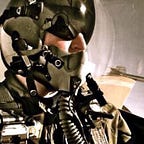The Silver Waterfall, a review
The Silver Waterfall, Captain Kevin P. Miller USN (ret). San Diego, CA. Braveship Books, 2020.
Early on the morning of June 4th, 1942, the situation in the Pacific remained bleak for the United States. Though the Americans had found recent strategic successes with the Battle of Coral Sea (April) and the ensuing Doolittle Raid (May), the Imperial Japanese Navy remained an ambitious and daunting threat. Admiral Yamamoto believed an attack, similar to that of the Pearl Harbor raid, would spell the end of the US Pacific fleet’s viability as a fighting force. He chose the tiny, yet strategically important, Midway Island atoll as the setting for what he believed would prove to be his greatest victory.
By the next morning however, Yamamoto had not only failed to destroy the American fleet, he’d failed to keep his own intact. In fact, what occurred on June 1942 set in motion a series of events that culminated with Japanese surrender on the deck of the USS Missouri in September 1945.
With this review, I’ve purposefully chosen to avoid a blow-by-blow retelling of the battle because there is no shortage of books that do this better than I can. Some of the more well-known contributions to this important history include The Battle of Midway by Craig Symonds, Shattered Sword: The Untold Story of the Battle of Midway by Jonathan Parshall and Anthony Tully, and Miracle at Midway by Gordon W. Prange, Donald M. Goldstein, and Katherine V. Dillon.
Those titles, familiar to historians, amateur WWII enthusiasts, and military students, each offer well-researched and detailed analyses of the battle. They succeed in their quests to provide a complete account of Midway’s planning, tactics, and operations, and each attempts to describe the human side of war, but the nature of nonfiction limits the effectiveness of this final aim. Where each of these books come up short, The Silver Waterfall — a work of historical fiction steps in to successfully fill the void.
The Silver Waterfall, released on the 78th anniversary of the Battle of Midway, is likely the most riveting addition to the Midway collection, due to the manner in which the story is told. That Miller chose to write fiction might suggest he didn’t do his homework or that he played fast and loose with important details. I found the opposite to be true.
The Silver Waterfall benefits from exhaustive research, study of primary source materials, first-person interviews, and Miller’s own experience as a carrier-based fighter pilot. His writing merges the verifiable truths of Midway with a credible, fascinating, and often heartbreaking treatment of the human element of war. His vivid imagery and first person experience brings the reader into the cockpits, ready rooms, and battles like no other author has been able to do. He provides an unvarnished look at how egos, service parochialism, and (more than anything else) individual acts of courage shaped the battle.
Students of Naval Aviation history are familiar with names like Raymond Spruance, Marc Mitscher, Clarence McCluskey, George Gay, and Dick Best, but likely as individuals. The Silver Waterfall goes further and peers into the relationships between these men, adding valuable context and depth that’s missed in other works. This matters because the outcomes of war, whether in 1942 or 2021, depend a great deal more on the decisions and actions of the combatants — the people — than any single piece of equipment or technology. The most unpredictable variable in the history of violent conflict has always been human. Midway was no different.
One of the most well written and evocative sections of The Silver Waterfall comes early in the morning of June 4th. After arguing with both the air group commander and the carrier captain over the composition of his own strike package and the location of the Japanese carriers, Lieutenant Commander John Waldron broke with the plan (and protocol), and set off with his squadron to find and attack the Japanese task force. Underpowered and lacking adequate maneuverability, the torpedo bombers’ low and slow run-in profiles made them easy targets for the much more capable Japanese A6M Zeroes. Without the benefit of fighter escort protection, speed, or surprise, all 15 of Waldron’s Douglas TBM Devastators were shot down, claiming the lives of all but one of the 30 aviators.
The story of John Waldron and VT-8 has been well documented in other histories of Midway but never in the way Miller has here. Written from the point of view only a career Naval Aviator could provide, the reader is given a glimpse of the nervous disbelief shared by a group of young ensigns as they wonder who to follow — their skipper, or their skipper’s boss, as the two argue over the radio. And again, in way that capitalizes on Miller’s experience and credibility, he brings us in to the cockpits as they’re raked with bullets, canopies explode, engines fail, and wingman perish. The imagery and prose are as powerful as they are effective.
With The Silver Waterfall, Kevin Miller easily answers the question why another book about Midway?
Because the men who fought and died deserve to have their stories told in a way that is unencumbered by the antiseptic nature of the historical non-fiction genre.
Following in the steps of luminaries like Michael Shaara (The Killer Angels), and Stephen Crane (The Red Badge of Courage), Miller brilliantly adds depth, intimacy, and personal connection to a story where imperfect men proved the difference between success and catastrophic failure. I cannot recommend this book strongly enough. In fact, for someone new to the study of WWII naval history, I recommend starting with this book before moving on to more traditional non-fiction, it’s that good.
